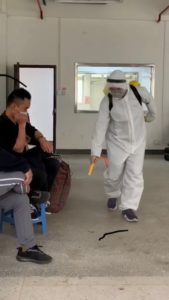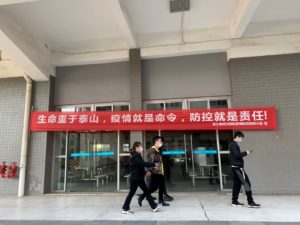This blog is part of the COMPAS Coronavirus and Mobility Forum.
Note: Mobility restrictions in Wuhan are changing rapidly. Since the time of writing this blog, the restrictions have relaxed and more people can get permission to leave the factory. Yet restrictions on using public transport are still in effect, making it difficult for workers to go places.
Anna had been away from the factory in Wuhan where she works for almost three months due to the COVID-19 shutdown when she returned on 10 April. On arrival, she first sat in a waiting room as a person clad in a white, plastic protective full bodysuit and mask disinfected the floor on which she and others entering the factory grounds had walked. A doctor swabbed her throat and took a vial of her blood. Then, Anna was directed to a dorm room where she and four other girls waited for three days to get their test results. When these came through, Anna returned to her single dorm room to resume her office work the next day.
As illustrated by the short film below, life on the factory grounds is different now, as many measures have been taken to prevent the spread of the virus. Red and white banners announce the new regulations: “No gathering, no visiting, no hand shaking. Wash hands, ventilate, work out. Wear a mask, wear a mask, wear a mask!”, “Life is invaluable! Controlling this epidemic is our responsibility!”. In the canteen, the tables have been fitted with white plastic screens that form barriers between those who come in to eat. In the office, automatic temperature measuring and shoe disinfecting equipment has been installed and work spaces are divided by large pieces of cardboard.
Factory Island
Yet the change with the largest impact pertains to the factory’s new regulations regarding workers’ mobility, which now requires workers to obtain special permission from the HR department to leave the factory grounds. Following a system that is called “two points one line” the applicant has to state the address s/he wishes to travel to and guarantee to use only private transport to get there. During the time spent outside of the factory, workers are required to check into an online system three times per day to confirm their location. This means that only those workers with a house in Wuhan and access to private transport can exit the factory grounds, leaving the large majority of all of the factory’s workers effectively locked in on the factory grounds. Currently the factory where Anna works has already announced that this policy will also be in effect during the upcoming 1 May holiday.

The floor gets disinfected in the waiting room upon entry; photo by Anna
Since official lock down has ended, employers in Wuhan have come to play a major role in managing people’s mobility. In some cases, as in the factory where Anna works, these restrictions are strict and explicit. In other cases, employers have not formulated specific restrictions, but encourage their employees to be risk-averse by shifting the responsibility for their health onto them. Those employers do not pay salaries if employees’ health status prevents them from working. Health status does not refer to a person’s actual health condition, but rather a status determined by a phone application that generates a QR-code, generally referred to as the “green code”. This code colours green, orange or red, depending on health data provided by people themselves and on the health status of people associated to them. People in Wuhan scan their green code when they leave and enter residential compounds, office buildings, and public places. An orange QR-code means restricted movement and a red code obliges a person to self-quarantine for fourteen days. The fear of losing one’s “green code” and thus the ability to work leads to people restricting their own mobility.
In our discussions, Anna argued that I should interpret her employer’s restrictions as a form of care: “Our employer paid for all its employees to be tested for the virus as they re-entered the factory, that is not a small cost!” Yet one might wonder what exactly is protected. Purporting to protect employees’ health, the measures are also aimed at safeguarding people’s ability to participate in production systems. This virus is therefore not an anti-capitalist force from nature, as it is sometimes portrayed as in the European media, but rather a force that illuminates how people are valued – and value themselves – mainly in economic terms.

Banner on the Campus; photo by Anna
Rather than speaking in terms of workers’ rights, youth from rural backgrounds lean on nationalist narratives that stimulate workers to make sacrifices for their employers. “Of course our companies cannot keep paying us when we don’t go in. We understand that. We are Chinese, we are not greedy people. You would probably expect to be paid”, said Hai Tao. He is a young man who works as an engineer for a mid-sized company in Wuhan that reduced employees’ salaries with twenty-five per cent during the lock down and has now notified its employees that salaries will not be paid during subsequent periods of self-isolation. Anna, whose employer is one of China’s largest companies, received her salary during lock down, and said it was something she felt “grateful” for and awkward about: “It’s a little awkward you know, if you get paid when you’re not even there.”
These statements and the agreements made between employers and employees illustrate the status of people from rural backgrounds working in cities. As their rural status makes them ineligible for state support and services, some employers fulfil the role of the state for them. After the lock down has been lifted, the focus for these workers has therefore been placed on protecting their ability to produce in order to continue receiving employers’ care.
Willy Sier is a postdoctoral fellow at the Department of Anthropology, University of Amsterdam
